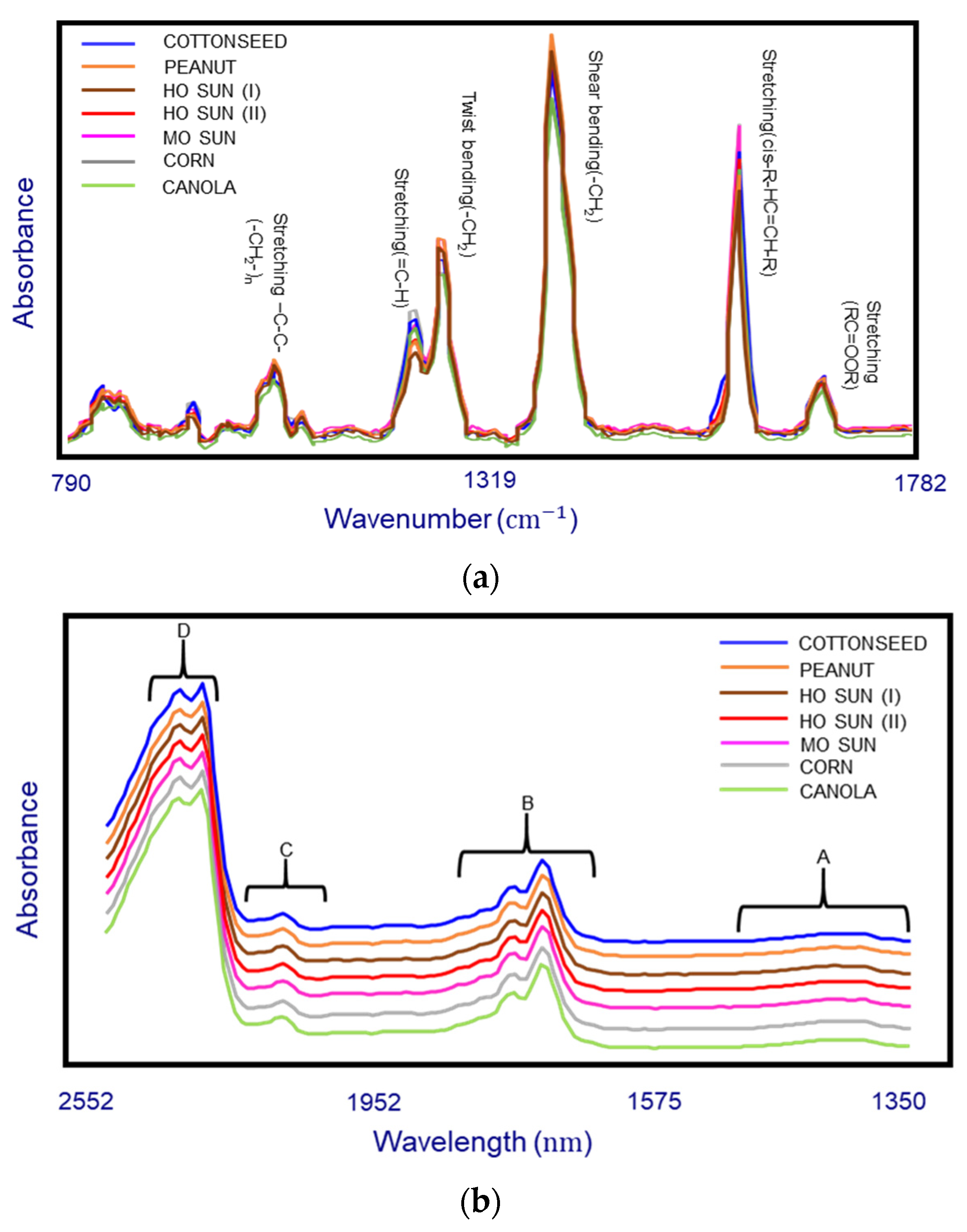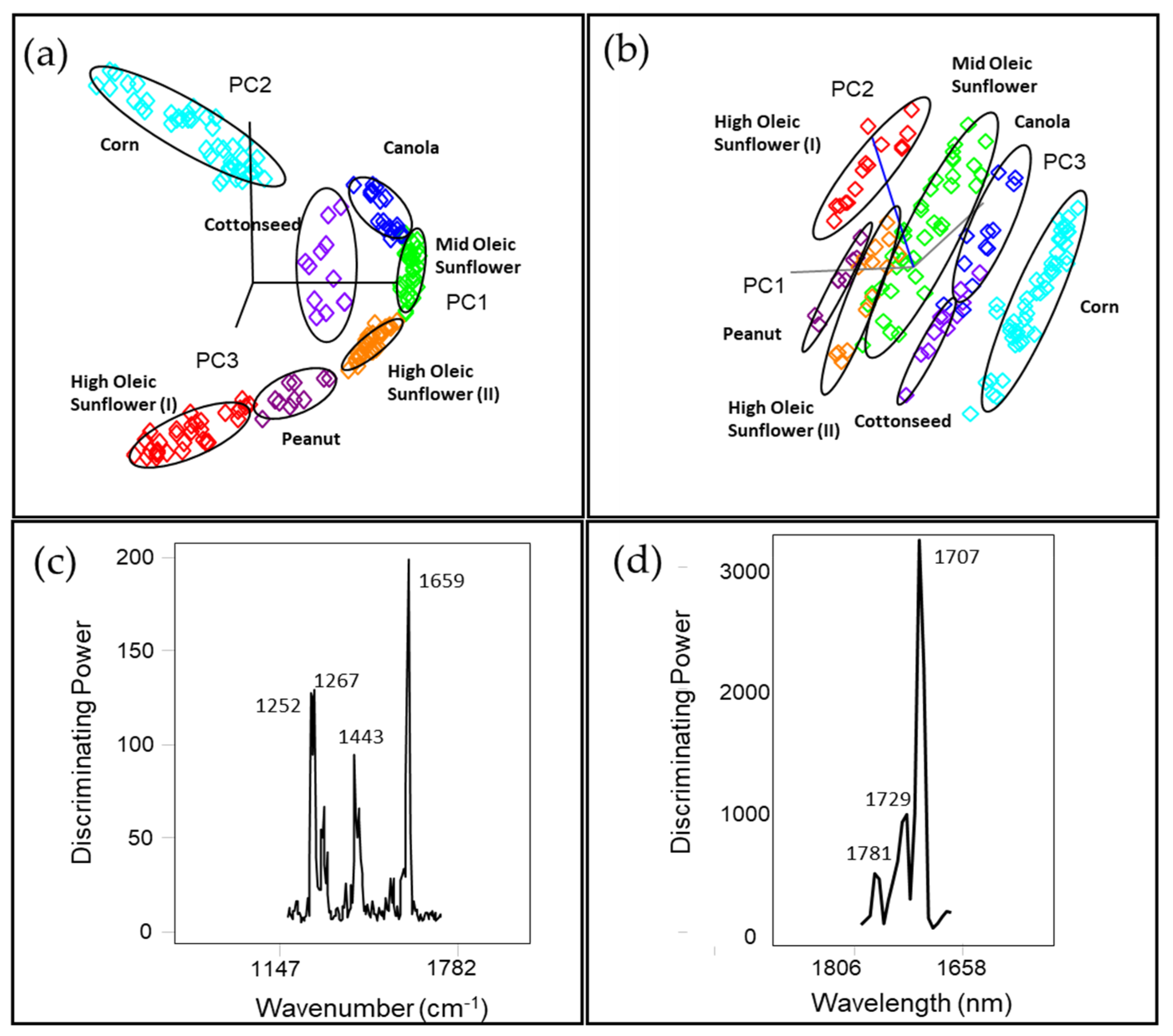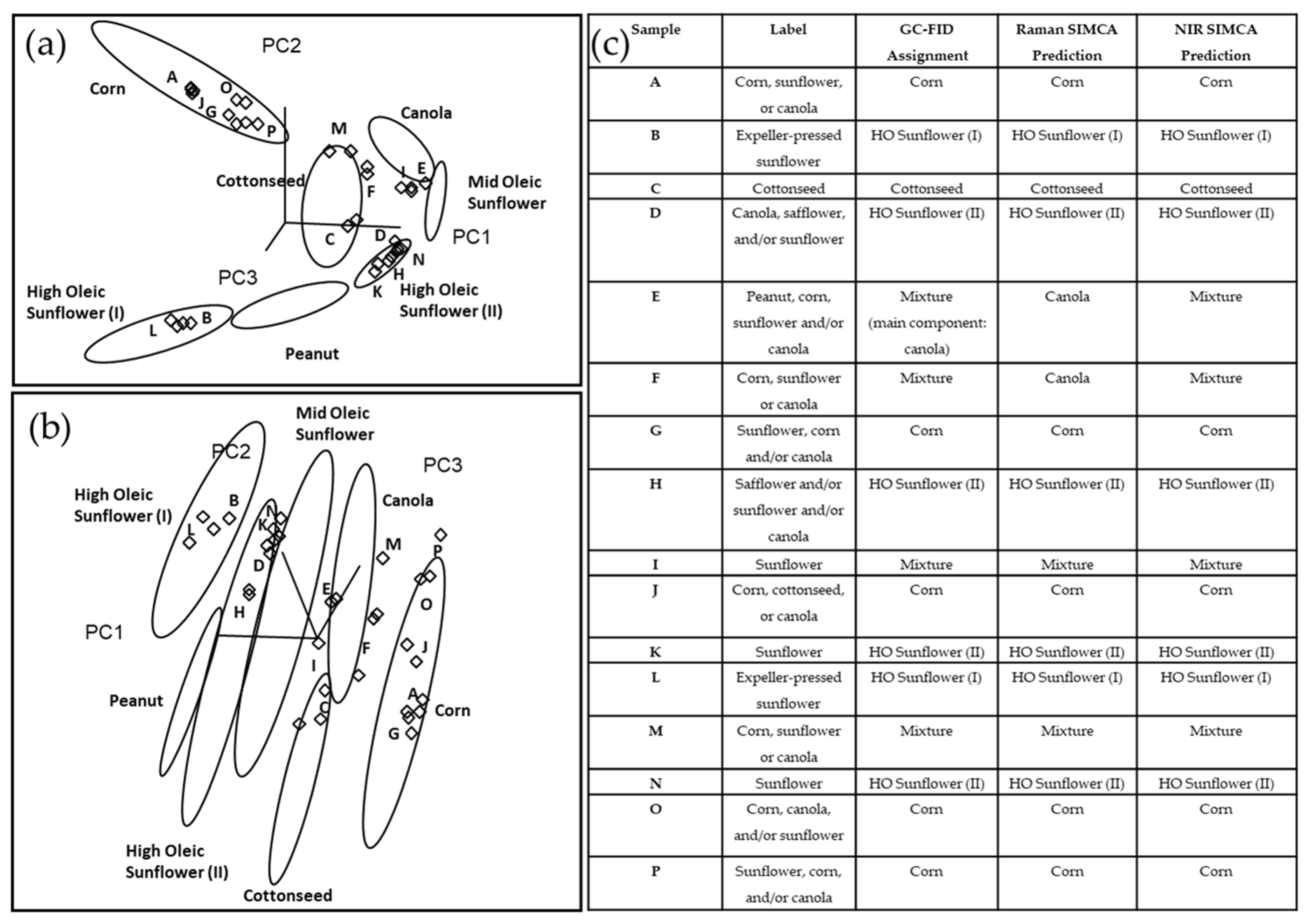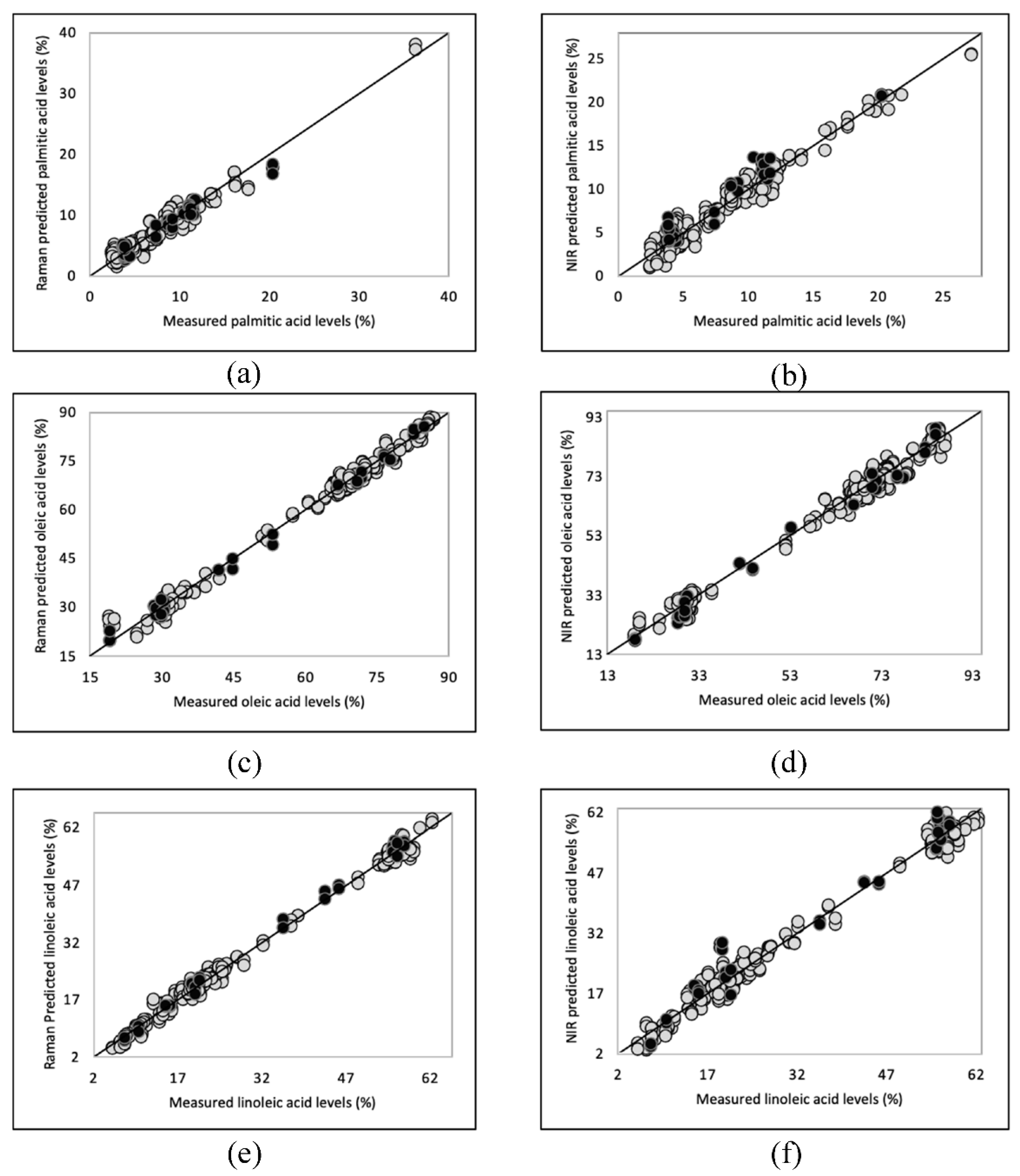Rapid Authentication of Potato Chip Oil by Vibrational Spectroscopy Combined with Pattern Recognition Analysis
Abstract
:1. Introduction
2. Materials and Methods
2.1. Reference Method
2.2. Spectral Data Acquisition
2.2.1. Raman Spectral Data Acquisition
2.2.2. NIR Spectral Data Acquisition
2.3. Multivariate Data Analysis
3. Results and Discussion
3.1. Characterization of Potato Chip Frying Oil (Fatty Acid Composition and Spectral Analysis)
3.2. Pattern Recognition Modeling for Raman and NIR Spectroscopy
3.3. PLSR Models for Raman and NIR Spectroscopy
4. Conclusions
Author Contributions
Funding
Acknowledgments
Conflicts of Interest
References
- Northern Plains Potato Growers Association Potato Fun facts. Available online: http://nppga.org/consumers/funfacts.php (accessed on 10 September 2020).
- Grand View Research U.S. Potato Chips Market Size, Share & Trends Analysis Report By Flavor (Flavored, Plain/Salted), By Distribution Channel (Supermarket, Convenience Stores), And Segment Forecasts, 2018–2025. Available online: https://www.grandviewresearch.com/industry-analysis/us-potato-chips-market (accessed on 10 June 2020).
- Process Sensors Corporation. Potato Chip Moisture and Oil. Available online: https://www.processsensors.com/industries/food/potato-chip-moisture-oil (accessed on 26 September 2020).
- Maarse, H. Vegetables. In Volatile Compounds in Foods and Beverages; Marcel Dekke, Inc.: New York, NY, USA, 1991; pp. 223–281. [Google Scholar]
- Maga, J.A. Potato flavor. Food Rev. Int. 1994, 10, 1–48. [Google Scholar] [CrossRef]
- Martin, F.L.; Ames, J.M. Comparison of flavor compounds of potato chips fried in palmolein and silicone fluid. JAOCS J. Am. Oil Chem. Soc. 2001, 78, 863–866. [Google Scholar] [CrossRef]
- Pedreschi, F.; Mery, D.; Marique, T. Quality Evaluation and Control of Potato Chips and French Fries. Comput. Vis. Technol. Food Qual. Eval. 2008, 545–566. [Google Scholar] [CrossRef]
- Aykas, D.P.; Rodriguez-Saona, L.E. Assessing potato chip oil quality using a portable infrared spectrometer combined with pattern recognition analysis. Anal. Methods 2016, 8, 731–741. [Google Scholar] [CrossRef]
- Imamura, F.; Micha, R.; Wu, J.H.Y.; de Oliveira Otto, M.C.; Otite, F.O.; Abioye, A.I.; Mozaffarian, D. Effects of Saturated Fat, Polyunsaturated Fat, Monounsaturated Fat, and Carbohydrate on Glucose-Insulin Homeostasis: A Systematic Review and Meta-analysis of Randomised Controlled Feeding Trials. PLoS Med. 2016, 13, 1–18. [Google Scholar] [CrossRef] [PubMed] [Green Version]
- Pimpin, L.; Wu, J.H.Y.; Haskelberg, H.; Del Gobbo, L.; Mozaffarian, D. Is butter back? A systematic review and meta-analysis of butter consumption and risk of cardiovascular disease, diabetes, and total mortality. PLoS ONE 2016, 11, 1–18. [Google Scholar] [CrossRef] [PubMed]
- Moore, J.C.; Spink, J.; Lipp, M. Development and Application of a Database of Food Ingredient Fraud and Economically Motivated Adulteration from 1980 to 2010. J. Food Sci. 2012, 77. [Google Scholar] [CrossRef]
- Jee, M. Oils and Fats Authentication; Blackwell Publishing Ltd.: Oxford, UK, 2002; pp. 1–24. [Google Scholar]
- Salimon, J.; Omar, T.A.; Salih, N. An accurate and reliable method for identification and quantification of fatty acids and trans fatty acids in food fats samples using gas chromatography. Arab. J. Chem. 2017, 10, S1875–S1882. [Google Scholar] [CrossRef] [Green Version]
- Giacomelli, L.M.; Mattea, M.; Ceballos, C.D. Analysis and characterization of edible oils by chemometric methods. JAOCS J. Am. Oil Chem. Soc. 2006, 83, 303–308. [Google Scholar] [CrossRef]
- Kang, J.X.; Wang, J. A simplified method for analysis of polyunsaturated fatty acids. BMC Biochem. 2005, 6, 4–7. [Google Scholar] [CrossRef] [Green Version]
- Kyriakidis, N.B.; Katsiloulis, T. Calculation of iodine value from measurements of fatty acid methyl esters of some oils: Comparison with the relevant American Oil Chemists Society method. J. Am. Oil Chem. Soc. 2000, 77, 1235–1238. [Google Scholar] [CrossRef]
- Dijkstra, A.J. Vegetable Oils: Composition and Analysis, 1st ed.; Elsevier Ltd.: Amsterdam, The Netherlands, 2015; ISBN 9780123849533. [Google Scholar]
- Nunes, C.A. Vibrational spectroscopy and chemometrics to assess authenticity, adulteration and intrinsic quality parameters of edible oils and fats. Food Res. Int. 2014, 60, 255–261. [Google Scholar] [CrossRef]
- Rodriguez-Saona, L.E.; Giusti, M.M.; Shotts, M. Advances in Infrared Spectroscopy for Food Authenticity Testing; Elsevier Ltd.: Amsterdam, The Netherlands, 2016; ISBN 9780081002209. [Google Scholar]
- Larkin, P. General Outline and Strategies for IR and Raman Spectral Interpretation. Infrared Raman Spectrosc. 2011, 117–133. [Google Scholar] [CrossRef]
- Jennifer Line Raman Spectroscopy and the Analysis of Gemstones. Available online: https://www.sas.upenn.edu/~lineje/ramanspectroscopy.html (accessed on 14 December 2020).
- Cherry, S.R.; Sorenson, J.A.; Phelps, M.E. Physics in Nuclear Medicine; Elsevier Ltd.: Amsterdam, The Netherlands, 2012; ISBN 9781416051985. [Google Scholar]
- Stuart, B.H. Infrared Spectroscopy: Fundamentals and Applications; Analytical Techniques in the Sciences; John Wiley & Sons, Ltd.: Chichester, UK, 2004; ISBN 9780470011140. [Google Scholar]
- McDowell, D.; Osorio, M.T.; Elliott, C.T.; Koidis, A. Detection of Refined Sunflower and Rapeseed Oil Addition in Cold Pressed Rapeseed Oil Using Mid Infrared and Raman Spectroscopy. Eur. J. Lipid Sci. Technol. 2018, 120, 1–10. [Google Scholar] [CrossRef] [Green Version]
- Ellis, D.I.; Muhamadali, H.; Haughey, S.A.; Elliott, C.T.; Goodacre, R. Point-and-shoot: Rapid quantitative detection methods for on-site food fraud analysis-moving out of the laboratory and into the food supply chain. Anal. Methods 2015, 7, 9401–9414. [Google Scholar] [CrossRef] [Green Version]
- Baeten, V.; Hourant, P.; Morales, M.T.; Aparicio, R. Oil and Fat Classification by FT-Raman Spectroscopy. J. Agric. Food Chem. 1998, 46, 2638–2646. [Google Scholar] [CrossRef]
- Dong, W.; Zhang, Y.; Zhang, B.; Wang, X. Rapid prediction of fatty acid composition of vegetable oil by Raman spectroscopy coupled with least squares support vector machines. J. Raman Spectrosc. 2013, 44, 1739–1745. [Google Scholar] [CrossRef]
- Aykas, D.P.; Karaman, A.D.; Keser, B.; Rodriguez-Saona, L. Non-targeted authentication approach for extra virgin olive oil. Foods 2020, 9, 221. [Google Scholar] [CrossRef] [Green Version]
- Ichihara, K.N.; Shibahara, A.; Yamamoto, K.; Nakayama, T. An improved method for rapid analysis of the fatty acids of glycerolipids. Lipids 1996, 31, 535–539. [Google Scholar] [CrossRef]
- Akpolat, H.; Barineau, M.; Jackson, K.A.; Akpolat, M.Z.; Francis, D.M.; Chen, Y.J.; Rodriguez-Saona, L.E. High-throughput phenotyping approach for screening major carotenoids of tomato by handheld raman spectroscopy using chemometric methods. Sensors 2020, 20, 3723. [Google Scholar] [CrossRef]
- Aykas, D.P.; Ball, C.; Sia, A.; Zhu, K.; Shotts, M.-L.; Schmenk, A.; Rodriguez-Saona, L. In-Situ Screening of Soybean Quality with a Novel Handheld Near-Infrared Sensor. Sensors 2020, 20, 6283. [Google Scholar] [CrossRef]
- Iacobucci, D.; Schneider, M.J.; Popovich, D.L.; Bakamitsos, G.A. Mean centering helps alleviate “micro” but not “macro” multicollinearity. Behav. Res. Methods 2016, 48, 1308–1317. [Google Scholar] [CrossRef] [PubMed]
- Duckworth, J. Mathematical Data Preprocessing. In Near-Infrared Spectroscopy in Agriculture; American Society of Agronomy, Inc.: Madison, WI, USA, 2004; pp. 115–132. [Google Scholar]
- Aykas, D.P.; Shotts, M.-L.; Rodriguez-Saona, L.E. Authentication of commercial honeys based on Raman fingerprinting and pattern recognition analysis. Food Control 2020, 117, 107346. [Google Scholar] [CrossRef]
- Massart, D.L.; Vandeginste, B.G.M.; Deming, S.M.; Michotte, Y.; Kaufman, L. Data Handling in Science and Technology; Elsevier Ltd.: Amsterdam, The Netherlands, 2001; ISBN 9780444828538. [Google Scholar]
- Caballero, B.; Trugo, L.C.; Finglas, P.M. Encyclopedia of Food Sciences and Nutrition; Elsevier Ltd.: Amsterdam, The Netherlands, 2003; ISBN 012227055X. [Google Scholar]
- Dubois, V.; Breton, S.; Linder, M.; Fanni, J.; Parmentier, M. Fatty acid profiles of 80 vegetable oils with regard to their nutritional potential. Eur. J. Lipid Sci. Technol. 2007, 109, 710–732. [Google Scholar] [CrossRef]
- Canolainfo.org. Classic and High-Oleic Canola Oils. Available online: https://www.canolacouncil.org/media/515008/classic_and_high-oleic_canola_oils.pdf (accessed on 8 November 2020).
- Worthington, R.E.; Hammons, R.O.; Allison, J.R. Varietal Differences and Seasonal Effects on Fatty Acid Composition and Stability of Oil from 82 Peanut Genotypes. J. Agric. Food Chem. 1972, 20, 729–730. [Google Scholar] [CrossRef]
- Vingering, N.; Oseredczuk, M.; Du Chaffaut, L.; Ireland, J.; Ledoux, M. Fatty acid composition of commercial vegetable oils from the French market analysed using a long highly polar column. OCL Ol. Corps Gras Lipides 2010, 17, 185–192. [Google Scholar] [CrossRef]
- Oklahoma State University Canola Oil Properties. Available online: https://extension.okstate.edu/fact-sheets/canola-oil-properties.html (accessed on 8 November 2020).
- Lindsay Nelson, R.D.L.D. High Oleic Sunflower Oil: Long Name, Great Benefits. Available online: https://fitjoyfoods.com/blogs/life-of-joy/high-oleic-sunflower-oil-long-name-great-benefits (accessed on 9 November 2020).
- USDA High Oleic Sunflower Oil. Available online: https://fdc.nal.usda.gov/fdc-app.html#/food-details/521139/nutrients (accessed on 9 November 2020).
- Fernández-Martínez, J.M.; Pérez-Vich, B.; Velasco, L.; Domínguez, J. Breeding for specialty oil types in sunflower. Helia 2007, 30, 75–84. [Google Scholar] [CrossRef]
- Huang, F.; Li, Y.; Guo, H.; Xu, J.; Chen, Z.; Zhang, J.; Wang, Y. Identification of waste cooking oil and vegetable oil via Raman spectroscopy. J. Raman Spectrosc. 2016, 47, 860–864. [Google Scholar] [CrossRef]
- Zhang, X.F.; Zou, M.Q.; Qi, X.H.; Liu, F.; Zhang, C.; Yin, F. Quantitative detection of adulterated olive oil by Raman spectroscopy and chemometrics. J. Raman Spectrosc. 2011, 42, 1784–1788. [Google Scholar] [CrossRef]
- Bailey, G.F.; Horvat, R.J. Raman spectroscopic analysis of the cis/trans isomer composition of edible vegetable oils. J. Am. Oil Chem. Soc. 1972, 49, 494–498. [Google Scholar] [CrossRef]
- Hourant, P.; Baeten, V.; Morales, M.T.; Meurens, M.; Aparicio, R. Oil and fat classification by selected bands of near-infrared spectroscopy. Appl. Spectrosc. 2000, 54, 1168–1174. [Google Scholar] [CrossRef]
- García Martín, J.F.; López Barrera MD, C.; Torres García, M.; Zhang, Q.A.; Álvarez Mateos, P. Determination of the acidity of waste cooking oils by near infrared spectroscopy. Processes 2019, 7, 304. [Google Scholar] [CrossRef] [Green Version]
- Yang, H.; Irudayaraj, J.; Paradkar, M.M. Discriminant analysis of edible oils and fats by FTIR, FT-NIR and FT-Raman spectroscopy. Food Chem. 2005, 93, 25–32. [Google Scholar] [CrossRef]
- Kvalheim, O.M.; Karstang, T.V. SIMCA-classification by means of disjoint cross validated principal components models. In Multivariate Pattern Recognition in Chemometrics, Illustrated by Case Studies; Elsevier Ltd.: Amsterdam, The Netherlands, 1992; pp. 209–248. [Google Scholar]
- Velioglu, S.D.; Ercioglu, E.; Temiz, H.T.; Velioglu, H.M.; Topcu, A.; Boyaci, I.H. Raman Spectroscopic Barcode Use for Differentiation of Vegetable Oils and Determination of Their Major Fatty Acid Composition. JAOCS J. Am. Oil Chem. Soc. 2016, 93, 627–635. [Google Scholar] [CrossRef]
- Bewig, K.M.; Clarke, A.D.; Roberts, C.; Unklesbay, N. Discriminant analysis of vegetable oils by near-infrared reflectance spectroscopy. J. Am. Oil Chem. Soc. 1994, 71, 195–200. [Google Scholar] [CrossRef]
- Orsavova, J.; Misurcova, L.; Vavra Ambrozova, J.; Vicha, R.; Mlcek, J. Fatty acids composition of vegetable oils and its contribution to dietary energy intake and dependence of cardiovascular mortality on dietary intake of fatty acids. Int. J. Mol. Sci. 2015, 16, 12871–12890. [Google Scholar] [CrossRef]
- Shotts, M.L.; Plans Pujolras, M.; Rossell, C.; Rodriguez-Saona, L. Authentication of indigenous flours (Quinoa, Amaranth and kañiwa) from the Andean region using a portable ATR-Infrared device in combination with pattern recognition analysis. J. Cereal Sci. 2018, 82, 65–72. [Google Scholar] [CrossRef]
- Casale, M.; Oliveri, P.; Casolino, C.; Sinelli, N.; Zunin, P.; Armanino, C.; Forina, M.; Lanteri, S. Characterisation of PDO olive oil Chianti Classico by non-selective (UV-visible, NIR and MIR spectroscopy) and selective (fatty acid composition) analytical techniques. Anal. Chim. Acta 2012, 712, 56–63. [Google Scholar] [CrossRef]
- Sato, T. Nondestructive measurements of lipid content and fatty acid composition in rapeseeds (Brassica napus L.) by near infrared spectroscopy. Plant Prod. Sci. 2008, 11, 146–150. [Google Scholar] [CrossRef]





| Corn | Canola | HO SUN a (I) | HO SUN a (II) | MO SUN b | Peanut | Cottonseed | ||
|---|---|---|---|---|---|---|---|---|
| Palmitic (%) C16:0 | Range | 8.4–14.1 | 2.9–4.7 | 2.4–5.2 | 2.5–4.9 | 3.5–5.9 | 3.0–5.0 | 17.6–21.8 |
| Mean | 11 | 3.9 | 4.2 | 3.9 | 4.5 | 4.2 | 20 | |
| SD | 1.4 | 0.7 | 0.8 | 0.7 | 0.7 | 0.9 | 1.6 | |
| Reference oils | 9.6 | 3.9 | 2.8 | —— | 3.4 | 8.1 | 16.8 | |
| Stearic (%) C18:0 | Range | 1.6–2.3 | 1.9–2.1 | 2.9–3.8 | 1.7–4.3 | 2.1–4.2 | 2.5–3.3 | 2.6–3.2 |
| Mean | 1.9 | 2 | 3.4 | 3.2 | 3.5 | 2.9 | 2.9 | |
| SD | 0.2 | 0.1 | 0.3 | 0.9 | 0.8 | 0.4 | 0.3 | |
| Reference oils | 1.8 | 1.9 | 2.6 | —— | 3.5 | 3.1 | 2.9 | |
| Oleic (%) C18:1 n-9 | Range | 28.3–32.3 | 66.6–68.7 | 82.0–87.1 | 70.9–78.9 | 64.1–69.9 | 75.6–81.4 | 18.9–20.1 |
| Mean | 30.5 | 67.6 | 83.9 | 74.3 | 67.6 | 78.5 | 19.2 | |
| SD | 0.9 | 0.7 | 1.7 | 2.5 | 1.6 | 2.6 | 0.5 | |
| Reference oils | 30 | 66.5 | 84.3 | —— | 66.6 | 66.6 | 20.6 | |
| Linoleic (%) C18:2 n-6 | Range | 54.5–58.5 | 18.4–19.5 | 6.7–10.4 | 14–21.9 | 22.5–27.6 | 11.4–15.4 | 57.0–59.1 |
| Mean | 55.7 | 19.1 | 8.4 | 17.7 | 24.3 | 13.8 | 57.9 | |
| SD | 1 | 0.4 | 1.2 | 2.5 | 1.3 | 1.7 | 0.9 | |
| Reference oils | 57.6 | 19.4 | 10.3 | —— | 26 | 25.9 | 59.4 | |
| Linolenic (%) C18:3 n-3 | Range | 0.6–1.0 | 6.2–9.1 | 0.0–0.8 | 0.2–2.4 | 0.1–1.4 | 0–0.8 | 0.0–0.2 |
| Mean | 0.9 | 7.5 | 0.2 | 0.8 | 0.4 | 0.4 | 0.2 | |
| SD | 0.1 | 1.1 | 0.2 | 0.8 | 0.3 | 0.4 | 0.1 | |
| Reference oils | 1.1 | 8.4 | 0 | —— | 0.5 | 0.4 | 0.2 |
| Groups | HO SUN (I) | MO SUN | Canola | HO SUN (II) | Peanut | Corn | Cottonseed |
|---|---|---|---|---|---|---|---|
| (a) | |||||||
| HO SUN (I) | 0.0 | ||||||
| MO SUN | 3.6 | 0.0 | |||||
| Canola | 7.1 | 1.5 | 0.0 | ||||
| HO SUN (II) | 2.0 | 0.9 | 3.3 | 0.0 | |||
| Peanut | 1.3 | 3.1 | 6.5 | 1.3 | 0.0 | ||
| Corn | 10.1 | 4.5 | 3.2 | 5.8 | 9.7 | 0.0 | |
| Cottonseed | 7.2 | 3.7 | 3.0 | 3.8 | 7.0 | 2.6 | 0.0 |
| (b) | |||||||
| HO SUN (I) | 0.0 | ||||||
| MO SUN | 3.8 | 0.0 | |||||
| Canola | 44.8 | 11.8 | 0.0 | ||||
| HO SUN (II) | 6.2 | 2.9 | 25.3 | 0.0 | |||
| Peanut | 8.7 | 10.5 | 34.7 | 7.2 | 0.0 | ||
| Corn | 13.0 | 5.5 | 15.5 | 14.5 | 39.0 | 0.0 | |
| Cottonseed | 40.2 | 14.5 | 13.9 | 26.1 | 36.1 | 12.0 | 0.0 |
| Model Types | Sensitivity (%) | Specificity (%) |
|---|---|---|
| Raman | 100 | 50 |
| NIR | 100 | 100 |
| Approach | Fatty Acid | Training Model | External Validation Model | |||||||
|---|---|---|---|---|---|---|---|---|---|---|
| Range | Na | Factor | SECV b | Rcal | Range | Nc | SEP d | Rval | ||
| Raman | Palmitic (%) | 2.4–36.3 | 101 | 6 | 1.08 | 0.98 | 3.7–20.3 | 16 | 1.08 | 0.97 |
| Oleic (%) | 18.9–86.9 | 102 | 6 | 2.26 | 1 | 19.1–84.9 | 16 | 1.84 | 1 | |
| Linoleic (%) | 5.3–62.4 | 102 | 6 | 1.48 | 1 | 7.5–57.5 | 16 | 1.31 | 1 | |
| NIR | Palmitic (%) | 2.5–27.2 | 94 | 6 | 1.06 | 0.98 | 3.7–20.3 | 16 | 1.60 | 0.97 |
| Oleic (%) | 18.9–86.9 | 95 | 6 | 2.61 | 0.99 | 19.1–84.9 | 16 | 2.87 | 0.99 | |
| Linoleic (%) | 5.3–62.4 | 101 | 6 | 2.47 | 0.99 | 7.5–57.5 | 16 | 3.55 | 0.99 | |
Publisher’s Note: MDPI stays neutral with regard to jurisdictional claims in published maps and institutional affiliations. |
© 2020 by the authors. Licensee MDPI, Basel, Switzerland. This article is an open access article distributed under the terms and conditions of the Creative Commons Attribution (CC BY) license (http://creativecommons.org/licenses/by/4.0/).
Share and Cite
Yao, S.; Aykas, D.P.; Rodriguez-Saona, L. Rapid Authentication of Potato Chip Oil by Vibrational Spectroscopy Combined with Pattern Recognition Analysis. Foods 2021, 10, 42. https://doi.org/10.3390/foods10010042
Yao S, Aykas DP, Rodriguez-Saona L. Rapid Authentication of Potato Chip Oil by Vibrational Spectroscopy Combined with Pattern Recognition Analysis. Foods. 2021; 10(1):42. https://doi.org/10.3390/foods10010042
Chicago/Turabian StyleYao, Siyu, Didem Peren Aykas, and Luis Rodriguez-Saona. 2021. "Rapid Authentication of Potato Chip Oil by Vibrational Spectroscopy Combined with Pattern Recognition Analysis" Foods 10, no. 1: 42. https://doi.org/10.3390/foods10010042
APA StyleYao, S., Aykas, D. P., & Rodriguez-Saona, L. (2021). Rapid Authentication of Potato Chip Oil by Vibrational Spectroscopy Combined with Pattern Recognition Analysis. Foods, 10(1), 42. https://doi.org/10.3390/foods10010042







